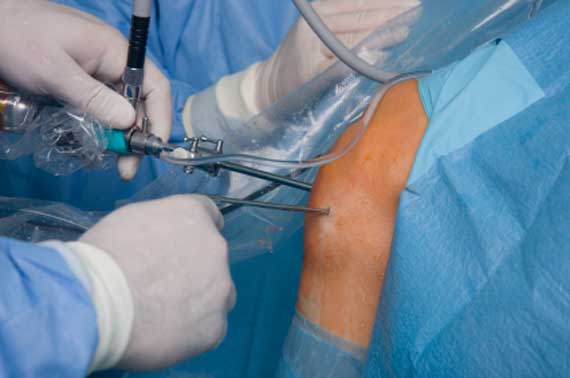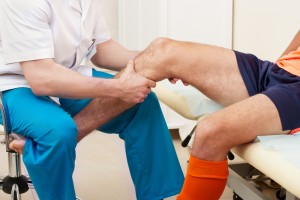There are two menisci within the knee joint — a medial meniscus and a lateral meniscus. The lateral meniscus sits more on the outside of the knee, the medial meniscus, sits more towards the inner aspect of the knee. Menisci act as shock absorbers within the knee and make the knee joint more stable. Before you start, it will be very helpful to review knee anatomy. You can always refer to this information later in the article.
Meniscal tears are common. A tear can occur in any age group. In young people, the meniscus is fairly tough, and tears usually happen from a very forceful twisting injury— e.g. sudden pivoting around a planted foot when playing tennis. Sports injuries aren’t the only causes of tears; tears can also happen with lifting. In older individuals, the meniscus is weaker, and tears of the meniscus can happen with smaller forces, such as the simple motion of squatting.
The pattern of meniscus tears can be quite variable. For example, the entire inner rim of the medial meniscus can be torn, called a bucket-handle tear because the torn area looks like a handle. Alternatively, there may just be a small tear of the inner meniscus or the meniscus may be completely frayed and torn in several directions.
Symptoms of a Meniscus Tear
Knee pain is the most common symptom of a meniscus tear. Depending on where the tear is, it may be on the inner or outer aspect of the knee, or even towards the back of the knee. Sometimes, the pain may be more diffuse. Sometimes the meniscus tear is associated with mechanical symptoms. Mechanical symptoms are symptoms that affect the normal and fluid function of the knee: knee catching, clicking, or locking. If the torn portion of the meniscus is large enough, your knee may lock up.
You may momentarily feel like you are unable to fully bend or straighten out your knee. This happens because a torn part of the meniscus flaps into the joint and gets caught within, preventing the knee from functioning normally. If the knee becomes permanently locked up, urgent surgery is required. More frequently, however, these mechanical symptoms occur more intermittently. These symptoms may additionally be associated with pain.
If the meniscus tear is large enough, it can cause long-term problems. Because the meniscus acts as a shock absorber, loss of the normal function of the meniscus may lead to increased wear on the cartilage leading to early onset osteoarthritis of the knee joint.
How to Diagnose a Torn Meniscus
The diagnosis of a torn meniscus begins with your doctor asking you questions about any injury that may have started your symptoms and the quality of your symptoms themselves. Your doctor will perform an examination of your knee to give him/her clues regarding your injury.
Regular X-rays do not show a torn meniscus, as the tissue of the meniscus is not dense enough to be seen on X-ray. X-rays are mainly useful to look at the bones. Depending on your symptoms, your doctor may order an MRI scan to get a better look at the menisci. An MRI is very good at evaluating the soft tissue structures around the knee, including the menisci.
Treatment for a Torn Meniscus
The size, location, chronicity of the meniscus tear as well the presence of any additional injuries will help to determine what treatment is needed. Oftentimes, meniscus tears that are not accompanied by mechanical symptoms (locking, catching) can be initially treated non-surgically with rest, ice, and anti-inflammatory medications.
If your pain continues despite non-surgical treatment or you are experiencing mechanical symptoms, you and your surgeon may decide that surgery is the next step for you. In this situation, treatment of meniscal tears typically includes either partial removal or repair. Whether the meniscus is repaired or removed will depend on many factors including your age, any additional injuries or associated arthritis within the knee, and the pattern, and location of the tear.
For instance, if the tear is located on the outer 1/3 of the meniscus, the tear is more likely to heal due to better blood supply, and a repair may help it to do so. Tears of the inner 1/3 of the meniscus are unlikely to heal because of poor blood supply. Consequently, these tears are often simply removed.
Most meniscus surgery nowadays is done arthroscopically. The orthopedic surgeon makes small incisions around the knee to allow the insertion of a small camera and other special instruments into the knee joint to address your meniscus tear.
Ultimately, the final decision to repair or partially remove a meniscus is made by your surgeon at the time of surgery when the injury can be directly visualized with the arthroscopic camera. It is only then that the surgeon can truly understand if the tear is repairable. If the tear is repairable, sutures are used to sew up the tear.
It is important to remember that not all meniscal tears require surgery i.e. just because somebody says there is a meniscal tear on your MRI, doesn’t mean that you need surgery. Understanding when surgery is needed will depend on your symptoms, your age, any additional injuries or any underlying arthritis, and your ultimate functional goals. Only you and your orthopedic surgeon can make this decision together.

How long does the surgery take?
If you are only having meniscal surgery done, the surgery lasts approximately 30 minutes to an hour. If other problems within the knee need to also be addressed at the same time, it can take a bit longer. Surgery is typically performed in an outpatient setting — meaning, you go home the same day as surgery.
What kind of scar will I have?
Usually, only a few small incisions are made around the knee for this operation. Scarring is typically minimal.
Recovery
 Recovery time will depend on the severity of the injury and if a repair was performed. Generally, only a couple weeks or so are needed for recovery after undergoing a partial menisectomy (removal).
Recovery time will depend on the severity of the injury and if a repair was performed. Generally, only a couple weeks or so are needed for recovery after undergoing a partial menisectomy (removal).
However, in the setting of a repair, recovery time is expected to be longer. In some situations, it may be up to three months.
Ultimately, this decision is made by your surgical team. Be sure to ask these questions at your pre-operative appointment.
Postoperative medications
Ask your surgeon what medications they recommend that you take during your recovery. Likely they will prescribe a pain medication and possibly an anti-inflammatory (to reduce swelling). Depending on what surgery was performed, they may also recommend the use of compression stockings or give you a medication to prevent blood clots.
Will I need to do physical or rehabilitation therapy?
Physical therapy is usually recommended after meniscus surgery. Consult with your surgeon or physical therapist before trying any exercises on your own. Some physicians will recommend non-weight bearing activities for a period of time (depending on the surgery performed) and others may want you to start trying weight-bearing activities sooner in your recovery. Always consult your surgeon first and follow their instructions.
Complications
Although complications are rare and arthroscopic surgery is considered low-risk, the following are possible complications of having meniscus surgery:
- Damage to skin nerves
- Infection
- Knee pain and/or stiffness
- Blood clots
- Blood loss
- Knee popping after surgery
Note that the information in this article is purely informative and should never be used in place of the advice of your treating physicians.

